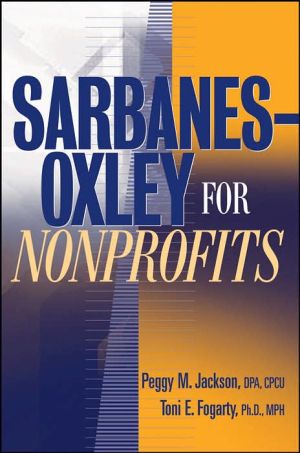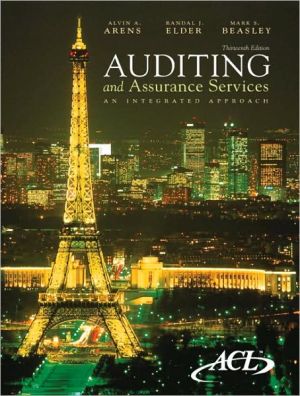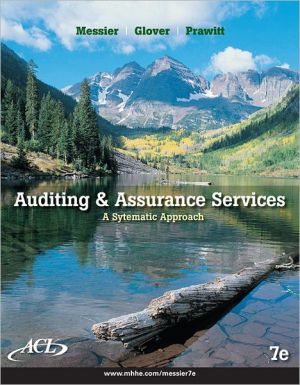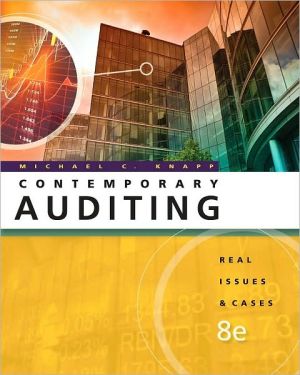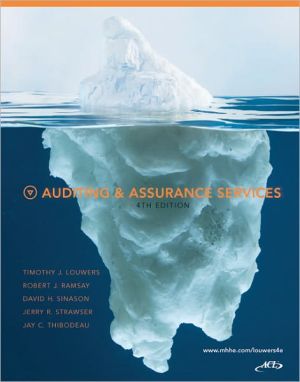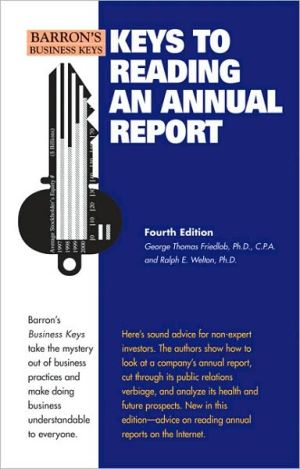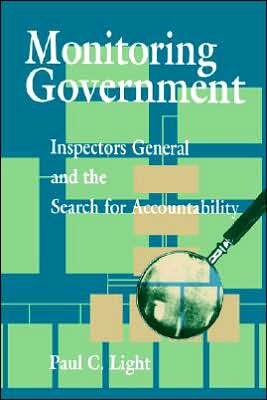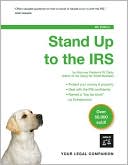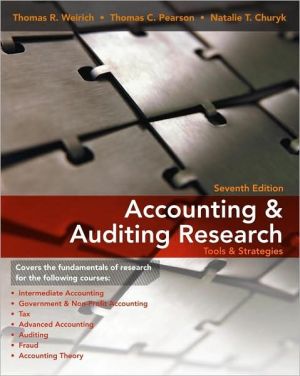Sarbanes-Oxley for Nonprofits: A Guide to Gaining Competitive Advantage
A complete guide to leveraging the power of Sarbanes-Oxleyspecifically for nonprofits\ The first book to discuss the implications of Sarbanes-Oxley legislation as it relates to nonprofit organizations, Sarbanes-Oxley for Nonprofits is an essential guide for all nonprofit executives and boards who want to know how the new legislation can enhance their organization's mission.\ By establishing a "platinum standard" of operations and governance within nonprofit organizations, executives and...
Search in google:
Although only two provisions of the Public Company Reform and Investor Protection Act (Sarbanes-Oxley—SOX) apply to both nonprofit and publicly traded companies, the authors suggest that non-profit compliance with the best practices that have emerged from the legislation establishes a "platinum standard" and provides a competitive advantage for non-profits. After providing an overview of Sarbanes-Oxley, they present chapters on the role of audit committees and audits in SOX best practices, nonprofit accounting and financial statement, the role of IRS Form 99Os in nonprofit accountability, SOX required provisions of whistleblower protection and document retention, organizational culture and readiness to integrate SOX best practices, and the leveraging of SOX for competitive advantage. Annotation ©2006 Book News, Inc., Portland, OR
Sarbanes-Oxley for Nonprofits\ \ By Peggy M. Jackson \ John Wiley & Sons\ ISBN: 0-471-69788-5 \ \ \ Chapter One\ Overview of the Legislation and Its Implications for Nonprofits \ The scene is an elegant Minneapolis restaurant. Five career women are having lunch together. Lois is the CFO of a well-known nonprofit in the Twin Cities. Shelly is an attorney with a prominent law firm. Peg is an author and consultant. Toni is a professor, author, and consultant. Virginia is a community volunteer who sits on a number of prestigious nonprofit boards. She is also the Chair of the Board of a historic Minneapolis landmark. The women met for lunch that day because they were colleagues on a pro bono project. Peg attempted, once again, to convince Virginia that the conflict of interest presented by a staff member was indeed a serious issue, and the discussion turned to Sarbanes-Oxley. Virginia emphatically stated, "Sarbanes-Oxley has nothing to do with nonprofits! You don't know what you are talking about!" Both Peg and Toni attempted in vain to dissuade Virginia of this notion.\ Yes, Virginia, Sarbanes-Oxley does apply to nonprofits!\ What Is the Sarbanes-Oxley Legislation About?\ The Public Company Accounting Reform and Investor Protection Act was passed in 2002 in the wake of the Enron corporate scandal. The act is commonly referred to as the Sarbanes-Oxley Act (SOX), named after Senator Paul Sarbanes (D-MD) and Representative Michael Oxley (R-OH), who wereits main sponsors. Although SOX was initially intended to raise the bar for integrity and competence for publicly traded companies, its effect has been to promote greater accountability within both the nonprofit and private sector. Along with public companies such as Enron, the nonprofit world has seen high-profile scandals such as those involving the United Way and the American Red Cross. Subsequent to these nonprofit scandals, legislatures in both New York and California have begun deliberations on SOX "clones," targeting nonprofit accountability. In a similar vein, the U.S. Senate Finance Committee conducted hearings in June 2004 and published some proposed actions to raise the bar for nonprofit accountability. These proposals include:\ Require nonprofits to have their Internal Revenue Service (IRS) tax exempt status reviewed every five years, with extra documents and a new processing fee\ Increase information disclosures on IRS Form 990, including annual performance goals and measurements for meeting those goals\ Require Form 990 to be signed by an organization's chief executive officer (CEO) or equivalent under penalties or perjury\ Create penalties for failure to file a complete and accurate 990\ Appropriate $10 million for various forms of nonprofit accreditation\ Establish an Exempt Organization Hotline for reporting abuses by charities and complaints by donors and beneficiaries\ Limit board size to 15 members\ The tone of the preceding proposals should be unmistakable. Public pressure is mounting to have nonprofits come under a higher level of scrutiny and regulation. Although only two provisions of SOX apply to both nonprofit and publicly traded companies (whistleblower protection and document preservation), visible compliance with SOX standards establishes a "platinum standard" and a marketing competitive advantage that can provide benefits to any nonprofit. Best practices that emerge from SOX compliance include:\ A more effective board whose members understand and adhere to their fiduciary obligations and recognize their responsibility in governing the nonprofit\ Higher level of management and staff accountability\ Effective protocols to ensure that the nonprofit remains in compliance with SOX and nonprofit "industry standards" and addresses future standards\ Better competitive positioning by making known that the nonprofit adheres to the SOX platinum standard in its operating practices\ Greater credibility and ability to recruit high-quality board members and to attract the favorable attention of major donors, foundations, and other funding sources\ SOX is the latest in a long progression of regulatory reform aimed at rectifying corporate misdeeds. A brief look at a segment of this country's economic history addresses the following questions:\ What events brought about legislation that addresses corporate misdeeds?\ What areas of business and nonprofit operations are facing more scrutiny and why?\ What are the features of SOX and what are the best practices that emerge from this law?\ Why have these best practices raised the bar for nonprofits?\ Sox Has Its Roots in the Great Depression\ The Great Depression, which began in 1929 and lasted more than a decade, was one of the deepest economic slumps to affect the United States, Europe, and other industrialized countries. Although the actual causes of the Great Depression are still intensely debated, some of the factors believed to contribute to the Great Depression in the United States were the mass stock speculation that occurred during the 1920s; a general imbalance of purchasing power and wealth in that a large percentage of the population was poor while a small percentage was very wealthy; the laissez-faire economic philosophy adhered to by Presidents Warren Harding (1920-1923), Calvin Coolidge (1923-1928), and Herbert Hoover (1929-1933); and the catastrophic crash of stock prices on the New York Stock Exchange (NYSE) in 1929. On October 29, 1929, known as "Black Tuesday," the U.S. stock market crashed, and the value of stock steeply plummeted. Black Tuesday was one of the worst trading days in the history of the stock market. Stock prices collapsed and most of the financial gains of the previous year were wiped out within the first few hours of the market's opening. Since most Americans viewed the stock market as the chief indicator of the health of the economy, the 1929 crash destroyed public confidence in both the stock market and in the U.S. economy.\ Stock value continued to fall for approximately three years, until late 1932. By that time, stocks had lost 80 percent of their value from 1929. Individual investors suffered devastating losses; overnight, large fortunes simply melted away with the decline in stock value. Many banks and other financial institutions, particularly those holding a large portion of stocks in their portfolios, also suffered severe losses in assets and by 1933, 11,000 of the 25,000 banks in the United States had failed. By 1932, the U.S. manufacturing output had declined to only 54 percent of its 1929 level, and unemployment had increased to between 12 and 15 million workers, approximately 25-30 percent of the labor force.\ Truth in Securities Law\ In part, the 1929 crash was blamed on wildly inflated stock prices, poor monetary policies imposed by the Federal Reserves Board, fraud, concealed or misleading financial information, the rampant buying of stock on margin, and inadequate controls on trading in the U.S. market. In 1932, the newly elected President Franklin D. Roosevelt and Congress sought to regulate the market by imposing controls on trading and requiring organizations that were offering securities for public sale to provide financial and other significant information about the securities being offered. Two significant pieces of legislation were passed, one in 1933 and the second in 1934. The Securities Act of 1933, which is frequently referred to as the "truth in securities" law, has two basic aims, to:\ Assure that investors are fully informed about the financial aspects of securities being offered for sale\ Prohibit deceit, misrepresentations, and other fraud in securities transactions\ The Securities Exchange Act of 1934 created the Securities and Exchange Commission (SEC) and gave it the power to regulate many aspects of the securities industry. The act also provided the SEC with the authority to require periodic reporting of financial information by organizations that offered publicly traded securities, and gave the SEC the power to register, regulate, and oversee brokerage firms, transfer agents, and the stock exchanges.\ Some of the important powers these two acts gave the SEC include:\ Regulate and register stock exchanges\ Register all securities listed on an exchange\ Regulate investment advisers and all dealers and brokers who are members of an organized exchange\ Require that audited and current financial reports be filed with the SEC\ Set accounting standards\ Prohibit all forms of stock price manipulation, such as insider trading\ The availability of properly audited and current financial reports enables investors to make informed and rational choices about whether to invest in a particular company. The audited financial reports are available from the organizations selling the securities in its stockholders' annual reports. Most are also easily accessible from the SEC, through EDGAR, the online Electronic Data Gathering, Analysis, and Retrieval system (sec.gov/edgar.shtml). EDGAR collects, validates, indexes, and disseminates the reports from companies that are required to file reports with the SEC.\ The SEC continues to protect investors today, adding stability to investors' confidence and the markets in general. Additional controls on the market after the 1987 crash regarding program trading and the institution of market shutdown mechanisms called circuit breakers helped to smooth out some of the volatility in the market. After the 1987 crash, the U.S. stock market appeared to be well regulated and well functioning.\ Twenty-First Corporate and Accounting Scandals\ At the beginning of the twenty-first century, the U.S. market and its investors were stunned by a string of corporate and accounting scandals. For several years, the Enron Corporation, an energy company, participated in a number of partnership transactions that lost the organization a substantial amount of money. In 2001, Enron reported that it had failed to follow generally accepted accounting practices in its financial statements for 1997 through 2001 by excluding these unprofitable transactions. In these erroneous financial statements, the organization reported large profits when, in fact, it had lost a total of $586 million during those years. Neither internal nor external controls detected the financial losses disguised as profits. The revelation of the erroneous financial reporting led to a collapse in the price of Enron stock. The price of Enron stock fell from $83 per share in December 2000 to less than $1 per share in December 2001. However, some of Enron's managers made millions of dollars by selling their company stock before its price plummeted. Other investors experienced substantial losses, including Enron employees who had invested a large portion of their retirement portfolios in Enron stock.\ Role of Arthur Andersen LLP The CPA firm of Arthur Andersen LLP, which had been one of the largest accounting firms in the world, served as Enron's auditor throughout the years of erroneous statements. The firm allegedly "overlooked" Enron's questionable accounting practices since it was making a large amount of money for providing Enron with consulting services and did not want to lose the consulting business. The firm was indicted by the U.S. Department of Justice, and in 2002, Arthur Andersen LLP was convicted of obstructing justice for shredding Enron-related documents requested by the SEC.\ The WorldCom Debacle In 2002, WorldCom, Inc., a prominent telecommunications company, admitted that it had failed to report more than $7 billion in expenses over five quarterly periods. Its financial statements indicated that WorldCom had been profitable over those quarters, when the company had actually lost $1.2 billion. WorldCom's market worth plunged from $200 billion to only $10 billion in July. In July 2002, WorldCom filed for Chapter 11 bankruptcy, causing concerns among its investors, creditors, and telecommunication customers.\ Enron and WorldCom were not the only companies that had questionable financial statements. Other corporate and accounting scandals included Tyco, Adelphia Communications, Xerox, and Global Crossing. These scandals understandably shook the public's confidence in the capital markets and in the integrity of corporate financial statements. In response to the lack of public confidence and the downward plummet in the stock market, the 107th Congress passed the Public Company Accounting Reform and Investor Protection Act, which was signed into law by President George W. Bush on July 30, 2002.\ Importance of SOX\ Many would agree that SOX is the single most important piece of legislation affecting corporate governance, financial disclosure, and public accounting since the passage of the Securities Act of 1933 and the Securities Exchange Act of 1934. SOX contains sweeping reforms for issuers of publicly traded securities, auditors, corporate board members, and lawyers. It adopts new provisions intended to deter and punish corporate and accounting fraud and corruption, and provides stiff penalties for noncompliance. In essence, SOX seeks to protect the interest of shareholders and employees by improving the overall quality of financial reporting, independent audits, corporate accountability, and accounting services for public companies. As can be seen in Exhibit 1.1, SOX consists of 11 titles, with each title having multiple sections.\ Title I\ Title I of SOX created a Public Company Accounting Oversight Board (PCAOB) that has extensive authority to regulate the auditors and audits of publicly held companies. The PCAOB is a nonprofit organization with strong ties to the SEC. Partial funding for the PCAOB comes from the SEC, the SEC has the power to appoint the PCAOB's chairperson and members, and the SEC must approve all rules and standards established by the PCAOB. Only accounting firms that have been accepted for registration with the PCAOB will be allowed to prepare or audit reports for companies registered with the SEC. Approval for registration with the PCAOB is based on a detailed application that requires the accounting firm to provide information regarding its audit clients, internal quality control policies and procedures, accounting personnel, licensure, and financial standing. In addition, approved firms must agree to undergo periodic inspections and provide annual reports to the PCAOB. Additional funding for the PCAOB will come from fees paid by the registered accounting firms.\ The PCAOB has the authority to establish standards and rules regarding the content of audits, the accounting firm's internal quality control policies and procedures, and the length of time that documents related to an audit must be retained. While the PCAOB does not have the direct power to set accounting standards, a separate accounting standards organization will develop the standards that the PCAOB will use.\ Nonprofits currently don't have a government-sponsored watchdog like the PCAOB, and the PCAOB currently has no authority over nonprofit organizations. The word currently is an important word in the previous sentence. Public and governmental policymakers have a growing concern about the performance and integrity. As discussed earlier, some states are already discussing SOX-like legislation that would cover nonprofits. The nonprofit industry just may end up with a watchdog similar to the PCAOB.\ Title II\ Title II of SOX details the rules to establish independence of the auditor from the company being audited. It defines which additional services the auditing firm may and may not provide, defines and prohibits conflicts of interest between auditors and the audited company, requires that the audited firm rotate its auditors on a regular basis, and requires the auditing committee of the audited company to be responsible for the oversight of its auditors. We discuss how this title can be used to help a nonprofit develop a SOX-like operating standard in Chapter 2.\ (Continues...)\ \ \ \ \ Excerpted from Sarbanes-Oxley for Nonprofits by Peggy M. Jackson Excerpted by permission.\ All rights reserved. No part of this excerpt may be reproduced or reprinted without permission in writing from the publisher.\ Excerpts are provided by Dial-A-Book Inc. solely for the personal use of visitors to this web site. \ \
Ch. 1Overview of the legislation and its implications for nonprofits1Ch. 2Safeguarding your nonprofit's financial resources and assets : establishing auditor independence and audit committee competence27Ch. 3Reading and interpreting financial statements39Ch. 4Form 990 : unnecessary paperwork or a useful tool?67Ch. 5SOX sections VIII and XI : document retention and whistleblower protection obligations75Ch. 6Raising the bar of accountability : SOX best practices and the board85Ch. 7SOX best practices and organizational culture : changing the environment103Ch. 8A platinum operating standard starts with good bones123Ch. 9Creating a competitive advantage : leveraging SOX best practices137Ch. 10SOX best practices for small nonprofits155App. AWorking through the four basic financial statements167App. BWhistleblower protection policy189App. CDocument retention and storage protocols191App. DAudit committee procedures and protocols195App. EConflict of interest policy197App. FCode of ethics for board and senior management201App. GBoard of directors - governance profile and performance expectations203App. HBoard orientation session207App. IReview of internal controls report and recommendations211App. JRisk management plan213App. KBusiness continuity plan219
